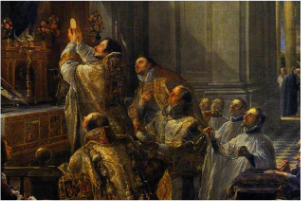 Hoc Est Enim Corpus Meum Hoc Est Enim Corpus Meum As many already know, Pope Benedict XVI, in his Motu Proprio Summorum Pontificum, has unambiguously clarified that any stable group of faithful Catholics desiring the Traditional Latin Mass is not only allowed to participate in it, but has always been allowed from time immemorial [1]. With this in mind, we would like to aid those desiring to participate in the Traditional Mass (in relation to Low Mass) by systematically outlining its parts and briefly commenting on the reasons for each. Since we are in no way competent enough to talk about such ancient and sacred things, we will turn our attention to those who are. The main guides for our tour of the Traditional Mass will be Alphonsus de Liguori, who is both a saint and doctor of the Church, and Venerable Dom Prosper Gueranger, who is known for reviving the Benedictine orders after the French Revolution in France [2]. In St. Alphonsus’ book The Holy Eucharist, he breaks down the Mass into two parts, which are further broken up into six distinct movements. After the present entry, we will expound upon the first of these movements, with the subsequent parts to follow in successive installments. First, a brief outline of the Mass in its entirety is in order. There are two major movements in the Mass. The first is The Mass of the Catechumens, which lasts from the prayers at the foot of the altar to the Creed. The second is The Mass of the Faithful, which begins with the Offertory and ends with the Last Gospel. It is within these two major parts of the Mass that St. Alphonsus identified the following six minor movements [3]: A) The Mass of the Catechumens 1) The Prayers at the Foot of the Altar 2) The Introit to the Credo (which includes the homily) B) The Mass of the Faithful 3) The Offertory to the Preface (which includes and ends with the Sanctus) 4) The Canon to the Pater Noster (which includes the Consecration) 5) The Breaking of the Bread to Communion (which includes the Agnus Dei) 6) The Thanksgiving to the Last Gospel With these movements of the Mass in mind, we will begin this series in our next post starting with the prayers at the foot of the altar. Until then it will be profitable to meditate upon the words of Rev. James Luke Meagher on the importance of ceremony and liturgy: “And this is written deep in the nature of man: We must have sensible signs and figures, for we are partly spiritual and partly corporal...And the truths of religion are spiritual, and the rites and ceremonies are corporal; yet as the soul is contained in the body, so the truths of religion are contained in the rites and ceremonies of the Church...show me a religion without rites and ceremonies, and I will show you a people drifting rapidly toward infidelity and the denial of all religion”[4]. _____________________________________________________________________________________________________ [1] “As for the use of the 1962 Missal as a Forma extraordinaria of the liturgy of the Mass, I would like to draw attention to the fact that this Missal was never juridically abrogated and, consequently, in principle, was always permitted.” http://w2.vatican.va/content/benedict-xvi/en/letters/2007/documents/hf_ben-xvi_let_20070707_lettera-vescovi.html
[2] You can read more about the fascinating lives of these two holy men here: St. Alphonsus Ligoure: http://www.newadvent.org/cathen/01334a.htm Venerable Dom Prosper Gueranger: http://www.crisismagazine.com/2014/ven-prosper-gueranger-refounding-solesmes [3] For those of you who would like an excellent and affordable traditional missal with the Latin and English side by side, you can find a copy of it here: http://www.ecclesiadei.org/Booklet%20Missals.htm. And if you would like a copy of the entire 1962 Missal, you can find it here: https://www.baroniuspress.com/book.php?wid=56&bid=4#tab=tab-1 [4] As quoted in Treasure and Tradition: The Ultimate Guide to the Latin Mass |
AuthorsThe authors of this blog are the tutors of Saint John of the Cross Academy: Archives
November 2016
Categories
All
|
 RSS Feed
RSS Feed